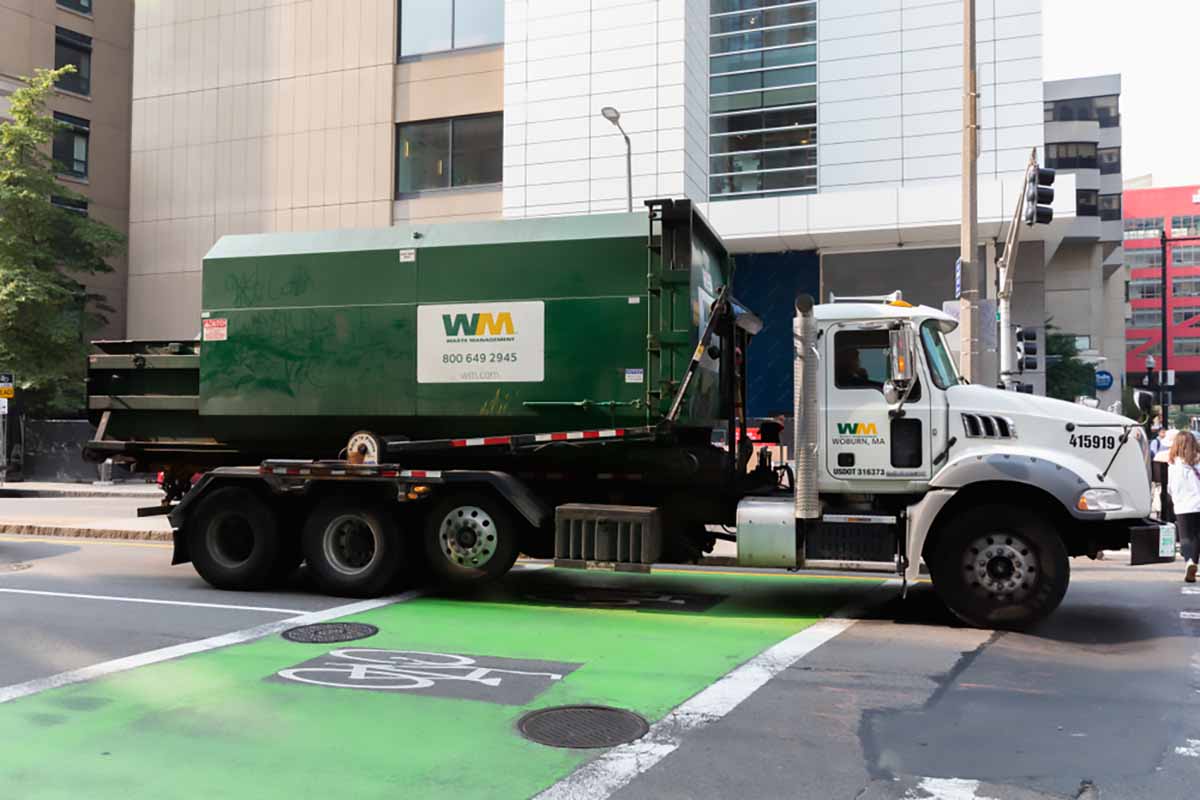
Waste Management’s recycling business revenues came in at $342 million during the first quarter, up 35% year over year. | 2p2play / Shutterstock
Higher commodity prices drove year-over-year recycling revenue increases for North America’s largest garbage and recycling companies.
Waste Management, Republic Services, Waste Connections, GFL Environmental and Casella Waste Services all reported big boosts in recycling revenue during the first quarter of 2021, compared with the first quarter of 2020.
For Waste Management, the largest hauler in North America, recycling profits also surged during the first quarter. The Houston-based company reported its recycling business earnings increased by $34 million year over year, a doubling of profits. An executive described the earnings as among the top five ever seen in the company’s recycling business.
The year-over-year commodity prices increases weren’t so much a result of extraordinarily high 2021 prices; rather, the dramatic difference – in some cases a doubling of average recyclables prices – was because prices were so low during the first quarter of 2020.
The following are first-quarter recycling-related results for the top five publicly traded haulers, organized by total revenue (Resource Recycling reported on their fourth-quarter 2020 and full-year 2020 results in March):
Waste Management
Higher recovered commodity prices drove a significant bump in Waste Management’s bottom line during the first quarter of 2021.
The average price of recyclables at Waste Management (WM) MRFs was $79 per ton during the first quarter. That was up 97% over the first quarter of 2020. Those bale prices helped drive WM’s recycling business revenues, which came in at $342 million during the first quarter, up 35% year over year.
Profits were also up in the recycling business. According to a press release, the recycling business’s operating earnings before interest, taxes, depreciation and amortization (EBITDA) were up by $34 million compared with the first quarter of 2020.
During an April 27 call with investors, John Morris, WM’s chief operating officer, described the $34 million increase as a doubling of recycling EBITDA year over year. Those earnings “rank in our top five best quarters ever,” he said.
“These results are truly a reflection of our work to improve the business model while creating a sustainable solution for our customers and not simply the result of an increase in recycled commodity prices,” he said, according to a transcript provided by Seeking Alpha.
In WM’s quarterly report, company leaders noted that the year-over-year commodity revenue boost was largely because the first quarter of 2020, when COVID-19 was first hitting North America, brought historically low prices. In fact, in the earnings call, WM CEO Jim Fish noted that the first quarter 2021 average price of $79 per ton is smack in the middle of historical averages.
And later quarters in 2020 experienced higher prices, particularly for fiber. As a result, the year-over-year increases likely won’t look as dramatic during the rest of this year, WM noted.
That being said, the company still enjoyed strong demand for recyclables during the first quarter of this year.
“We continue to see the demand for recycled materials outpace supply in the first quarter of 2021, driven by the growth in e-commerce, businesses starting to re-open, and manufacturers committing to use more recycled content in their packaging,” according to the quarterly report. We have also maintained our focus on converting to a fee-based pricing model that ensures fees paid by customers address the cost of processing materials and the impact on our cost structure of managing contamination in the recycling stream.”
Recycling now makes up over 8% of the company’s total operating revenue.
Overall, Waste Management’s revenue during the first quarter was $4.1 billion, up 10% year over year; however, much of that was because of WM’s Oct. 30, 2020 acquisition of Advanced Disposal Services (ADS), which was the fifth-largest publicly traded residential garbage and recycling company in North America (as measured by total revenue). Specifically, total WM revenue during the first quarter of 2021 was up $383 million from a year earlier. Of that amount, acquisitions contributed about $302 million.
WM didn’t provide a pro-forma statement showing what the recycling revenue would have looked like had WM theoretically owned ADS during the first quarter of 2020.
Republic Services
Republic’s recycling business brought in nearly $88 million in revenue during the first quarter, up 29% year over year.
Like the others, the company pointed to higher recyclables values contributing to the increase. During the first quarter, the company fetched an average of $133 per ton for material, excluding glass and organics. That was up from $76 per ton during the first quarter of 2020, according to the company’s quarterly report. The average price was $110 per ton during the fourth quarter of 2020, according to a Republic press release.
Along with the other large haulers, Republic has negotiated restructured MRF contracts in recent years to shift commodity market risk over to municipalities. According to a May 5 call with investors, Jon Vander Ark, president of Republic Services, said the company has restructured about 60% of its recyclables processing contracts and 50% of its residential recycling collection contracts.
“And that just tells us we have more work to do, right, because we have to move the model to one that becomes economically sustainable, where we get paid an appropriate return to collect the recycling, we get paid an appropriate return to process it. And then we can share in the commodity value,” he said, according to a transcript from Seeking Alpha. “But frankly, the customer, we think, is the natural owner of most of that and the volatility associated with that. So, I think we’ve done a good job of reducing the volatility on that front, but I also think there’s more upside as we move forward.”
Recycling now brings in over 3% of Republic’s total revenue. Overall, the company brought in nearly $2.6 billion in revenue during the quarter, up less than 2% year over year. Over half of the growth came from acquisitions that occured since the first quarter of 2020.
Waste Connections
Waste Connections’ recycling business brought in $32 million in revenue during the first quarter, up 79% year over year.
Those higher revenues were because of better recyclables prices and increased residential recycling volumes during the first quarter, according to the company’s quarterly report. Partially offsetting the financial benefits was less recyclable material coming from businesses, which were disrupted by COVID-19 starting in early 2020.
During an April 29 call with investors, Worthing Jackman, CEO of Waste Connections, said OCC averaged $108 per ton during the first quarter. That is above the high end of the company’s outlook.
During the call, Mary Ann Whitney, the company’s chief financial officer, noted that OCC had averaged $55 a ton during the first quarter of 2020, making the year-over-year increase about 96%.
Like WM officials, Whitney said commodity prices increased later in 2020, with OCC jumping from $55 a ton during the first quarter of 2020 to $110 a ton in the second quarter.
As a result, year-over-year surges aren’t expected in the next few earnings reports.
By the numbers
The following is a look at key first-quarter 2021 recycling numbers from the five largest publicly traded haulers in North America:
Waste Management
- Q1 recycling revenue: $342 million
- Revenue change YoY: Up 35%
- Average Q1 commodity price: $79 per ton
- Commodity price change: Up 97%
- Q1 recycling EBITDA change: Up by $34 million, roughly doubled YoY
Republic Services
- Q1 recycling revenue: $88 million
- Revenue change YoY: Up 29%
- Average Q1 commodity price (excluding glass and organics): $133 per ton
- Commodity price change: Up 75%
Waste Connections
- Q1 recycling revenue: $32 million
- Q1 revenue change YoY: Up 79%
- Average Q1 OCC price: $108 per ton
- OCC price change: Up 96%
GFL Environmental (converted to U.S. from Canadian dollars on May 7, 2021)
- Q1 recycling revenue: $66 million
- Revenue change YoY: Up 74%
Casella Waste Systems
- Q1 Resource Solutions segment revenue: $51 million
- Segment revenue change YoY: Up 8%
- Q1 commodity price change YoY: Up 150%
- Q1 segment net income: $2.5 million
- Segment net income YoY: Up 150%
Recycling now accounts for over 2% of Waste Connections’ revenue. Overall, the company brought in nearly $1.4 billion in revenue during the first quarter, up more than 3% year over year. All of that increase – and a little more – was because of acquisitions that occurred after the first quarter of 2020, according to the company.
GFL Environmental
GFL’s recycling business brought in nearly 81 million Canadian dollars (over $66 million; all dollars below converted to U.S. dollars on May 7) during the first quarter, up 74% year over year.
The numbers were affected by a number of acquisitions GFL made last year and early this year. Recycling is part of GFL’s solid waste segment, which is split between the U.S. and Canada (GFL is also involved in liquid waste, infrastructure and soil remediation). In the U.S. solid waste segment, almost all of the year-over-year revenue increase was because of acquisitions, and in the Canadian segment, acquisitions helped bump up revenue a little bit, according to GFL’s quarterly report.
Still, the company noted that higher commodity prices and greater volumes flowing through company MRFs did increase revenue during the first quarter. Total solid waste segment revenues increased 5.1% year over year; of that, 0.7 percentage points came from higher commodity prices, according to a company presentation.
During a May 6 call with investors, Patrick Dovigi, GFL’s founder and CEO, said commodity prices were slightly above the company’s expectations in the first quarter. He also touched on the company’s shift toward a fixed-price model for sorting recyclables.
“Although our strategic shift toward a fixed price processing model reduces the impact from commodity volatility, the rapidly changing pricing dynamics during the quarter provided a benefit to both revenues and margins,” he said, according to a transcript from The Motley Fool. “This is a tailwind we expect to continue, although the impact in Q2 will be muted on a tougher year-over-year comparison.”
Material recovery now makes up 7% of GFL’s total revenue. Overall, GFL pulled in $977 million during the first quarter, up 27% year over year. Again, acquisitions greatly affected the increase.
Casella Waste Systems
Casella’s Resource Solutions business, which includes recycling, brought in $51 million in revenue during the first quarter, up 8% year over year. Casella’s “Resource Solutions” segment includes its recycling and commodity brokerage operations, organics services, and large-scale commercial and industrial services.
Most of that year-over-year revenue bump, which totaled $3.8 million, came from higher recovered commodity prices. Specifically, higher prices boosted the segment revenue by $3.2 million, and greater recyclables volumes (both at company MRFs and in the brokerage business) added $600,000 to the increase, according to the company’s quarterly report.
During an April 30 call with investors, Ned Coletta, the company’s chief financial officer, said the average commodity revenue per ton in the first quarter was up 150% year over year. That was because of substantially higher OCC and mixed-paper prices, as well as higher metals and plastic prices.
Casella also reported that the Resource Solutions segment was more profitable. The segment tallied an operating income of $2.5 million during the first quarter of 2021. That was up from $1 million during the same period in 2020.
Resource Solutions accounts for 27% of total company operating revenue. Overall, Casella brought in $190 million in revenue during the first quarter of 2021, up nearly 4% year over year.
More stories about markets
- Box demand slump signals strain in US economy
- Federal Signal paves new way with acquisition
- Triple-digit revenue gains propel ABTC’s expansion



